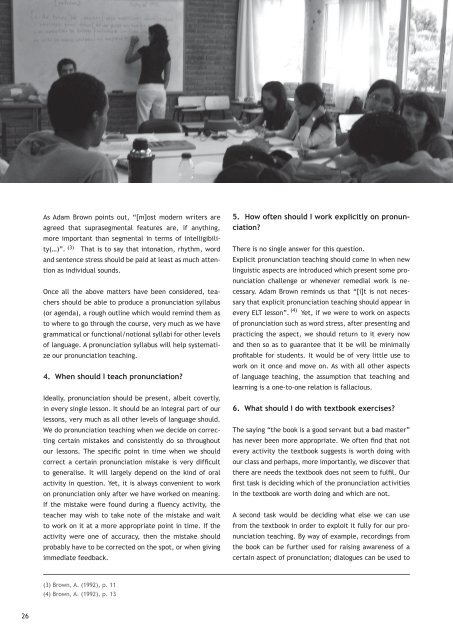Revista desde el Sur
1ra edición de la Revista desde el Sur del Centro Regional de Profesores del Sur
1ra edición de la Revista desde el Sur del Centro Regional de Profesores del Sur
Create successful ePaper yourself
Turn your PDF publications into a flip-book with our unique Google optimized e-Paper software.
As Adam Brown points out, “[m]ost modern writers are<br />
agreed that suprasegmental features are, if anything,<br />
more important than segmental in terms of int<strong>el</strong>ligibility(…)”.<br />
(3) That is to say that intonation, rhythm, word<br />
and sentence stress should be paid at least as much attention<br />
as individual sounds.<br />
Once all the above matters have been considered, teachers<br />
should be able to produce a pronunciation syllabus<br />
(or agenda), a rough outline which would remind them as<br />
to where to go through the course, very much as we have<br />
grammatical or functional/notional syllabi for other lev<strong>el</strong>s<br />
of language. A pronunciation syllabus will h<strong>el</strong>p systematize<br />
our pronunciation teaching.<br />
4. When should I teach pronunciation?<br />
Ideally, pronunciation should be present, albeit covertly,<br />
in every single lesson. It should be an integral part of our<br />
lessons, very much as all other lev<strong>el</strong>s of language should.<br />
We do pronunciation teaching when we decide on correcting<br />
certain mistakes and consistently do so throughout<br />
our lessons. The specific point in time when we should<br />
correct a certain pronunciation mistake is very difficult<br />
to generalise. It will larg<strong>el</strong>y depend on the kind of oral<br />
activity in question. Yet, it is always convenient to work<br />
on pronunciation only after we have worked on meaning.<br />
If the mistake were found during a fluency activity, the<br />
teacher may wish to take note of the mistake and wait<br />
to work on it at a more appropriate point in time. If the<br />
activity were one of accuracy, then the mistake should<br />
probably have to be corrected on the spot, or when giving<br />
immediate feedback.<br />
5. How often should I work explicitly on pronunciation?<br />
There is no single answer for this question.<br />
Explicit pronunciation teaching should come in when new<br />
linguistic aspects are introduced which present some pronunciation<br />
challenge or whenever remedial work is necessary.<br />
Adam Brown reminds us that “[i]t is not necessary<br />
that explicit pronunciation teaching should appear in<br />
(4)<br />
every ELT lesson”. Yet, if we were to work on aspects<br />
of pronunciation such as word stress, after presenting and<br />
practicing the aspect, we should return to it every now<br />
and then so as to guarantee that it be will be minimally<br />
profitable for students. It would be of very little use to<br />
work on it once and move on. As with all other aspects<br />
of language teaching, the assumption that teaching and<br />
learning is a one-to-one r<strong>el</strong>ation is fallacious.<br />
6. What should I do with textbook exercises?<br />
The saying “the book is a good servant but a bad master”<br />
has never been more appropriate. We often find that not<br />
every activity the textbook suggests is worth doing with<br />
our class and perhaps, more importantly, we discover that<br />
there are needs the textbook does not seem to fulfil. Our<br />
first task is deciding which of the pronunciation activities<br />
in the textbook are worth doing and which are not.<br />
A second task would be deciding what <strong>el</strong>se we can use<br />
from the textbook in order to exploit it fully for our pronunciation<br />
teaching. By way of example, recordings from<br />
the book can be further used for raising awareness of a<br />
certain aspect of pronunciation; dialogues can be used to<br />
(3) Brown, A. (1992), p. 11<br />
(4) Brown, A. (1992), p. 13<br />
26



